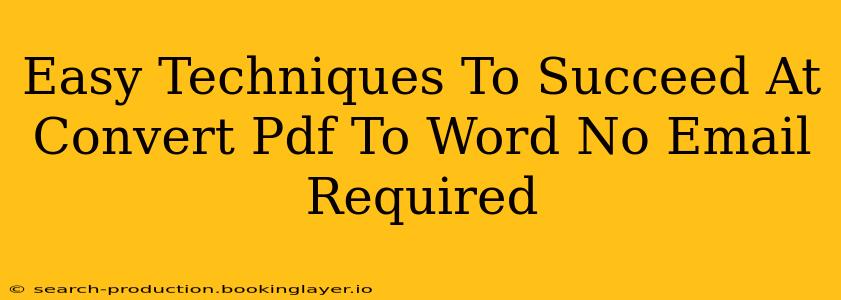Tired of clunky PDF to Word converters that bombard you with emails and subscriptions? You want a quick, easy conversion without the hassle. This guide provides simple techniques to successfully convert your PDFs to editable Word documents without sharing your email address.
Why Avoid Email-Required Converters?
Many online PDF to Word converters require email registration. This raises privacy concerns – who wants to give away their email address to an unknown service? Plus, you often end up inundated with unwanted spam emails. Fortunately, there are better ways!
Top Techniques for Effortless PDF to Word Conversion (No Email Needed)
Here are several effective methods to convert your PDFs to Word format without compromising your privacy:
1. Leverage Offline Software:
Several reputable software programs allow for direct PDF to Word conversion without any online registration or email requirements. These typically offer a free trial or a one-time purchase option. Some popular choices are:
- Adobe Acrobat Pro: While a paid software, it's the industry standard for PDF management and offers excellent conversion accuracy.
- Nitro PDF Pro: Another powerful option offering a range of features beyond simple conversion.
- Smallpdf Desktop App: A more user-friendly option for those seeking a simpler interface, this desktop app can handle many PDF-related tasks.
Pros: High accuracy, offline functionality, no email required. Cons: Usually requires a purchase or software installation.
2. Utilize Free Online Converters (With Caution):
While many free online converters demand emails, some reputable ones don't. Always check the privacy policy before uploading sensitive documents. Look for converters with positive user reviews and strong security measures.
Pros: Free and readily accessible. Cons: Potential privacy risks if not carefully chosen; conversion accuracy can vary.
3. Google Drive's Built-in Functionality:
If you're already a Google Drive user, you have a simple solution at your fingertips. Upload your PDF to Google Drive, open it with Google Docs, and it will automatically convert the file (with some formatting limitations).
Pros: Easy, integrated into an existing platform, no extra software needed. Cons: Accuracy can be inconsistent, especially with complex layouts.
4. OpenOffice's PDF Import:
OpenOffice, a free and open-source office suite, can import PDFs directly. While not a perfect conversion, it’s a viable option for basic PDFs.
Pros: Completely free and open-source, no online services or email registration needed. Cons: Conversion quality may be less accurate than dedicated software.
Tips for Optimal Conversion Results:
Regardless of the method you choose, these tips will improve your conversion results:
- Scanned PDFs: For scanned PDFs (image-based), Optical Character Recognition (OCR) is crucial for accurate text extraction. Many of the software options listed above include OCR functionality.
- Complex Layouts: Expect some formatting discrepancies with complex PDFs. Manual adjustments in Word may be necessary.
- Check Your File: Always review the converted Word document for accuracy and make necessary corrections.
Choosing the Right Method:
The best method depends on your needs and preferences. For high accuracy and offline functionality, dedicated software is ideal. For quick, occasional conversions, Google Drive or a carefully selected free online converter could suffice. Remember to prioritize your privacy by avoiding services that demand unnecessary personal information.
By following these techniques, you can easily convert your PDFs to Word documents without the annoyance of email registrations and maintain your privacy in the process. Choose the method that best fits your workflow and enjoy seamless PDF-to-Word conversion!

